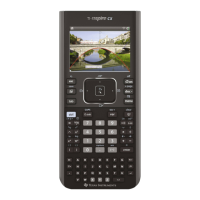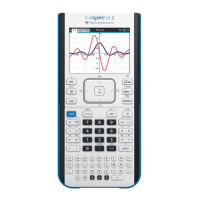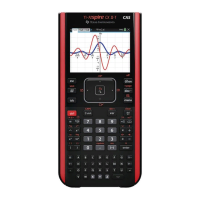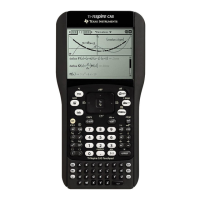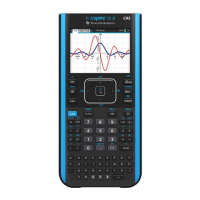TI-Nspire™ Reference Guide 111
X
While
Catalog
>
While Condition
Block
EndWhile
Executes the statements in Block as long as Condition is true.
Block can be either a single statement or a sequence of statements
separated with the “:” character.
Note for entering the example: In the Calculator application
on the handheld, you can enter multi-line definitions by pressing @
instead of · at the end of each line. On the computer keyboard,
hold down Alt and press Enter.
“With”
See
|
(“with”), page
128
.
xor
Catalog
>
BooleanExpr1 xor BooleanExpr2 ⇒ Boolean expression
Returns true if BooleanExpr1 is true and BooleanExpr2 is false, or
vice versa.
Returns false if both arguments are true or if both are false. Returns a
simplified Boolean expression if either of the arguments cannot be
resolved to true or false.
Note: See or, page 72.
Integer1 xor Integer2 ⇒ integer
Compares two real integers bit-by-bit using an xor operation.
Internally, both integers are converted to signed, 64-bit binary
numbers. When corresponding bits are compared, the result is 1 if
either bit (but not both) is 1; the result is 0 if both bits are 0 or both
bits are 1. The returned value represents the bit results, and is
displayed according to the Base mode.
You can enter the integers in any number base. For a binary or
hexadecimal entry, you must use the 0b or 0h prefix, respectively.
Without a prefix, integers are treated as decimal (base 10).
If you enter a decimal integer that is too large for a signed, 64-bit
binary form, a symmetric modulo operation is used to bring the value
into the appropriate range. For more information, see 4Base2,
page 12.
Note: See or, page 72.
In Hex base mode:
Important: Zero, not the letter O.
In Bin base mode:
Note: A binary entry can have up to 64 digits (not counting the
0b prefix). A hexadecimal entry can have up to 16 digits.

